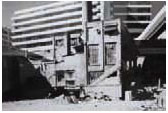It was around the middle of the last century when public authorities in Europe began to take an interest in finding modern solutions to the problems of urban hygiene and cleanliness. New ideas had to be found for the disposal of household waste and the elimination of unsanitary land and rubbish dumps located on the outskirts of the towns and cities that were growing in this new industrial era.
In France, in Paris, the Prefect Eugène POUBELLE gave his name to the receptacles designed to collect and store household waste.
In England, around 1840, the first incinerators were installed and put into operation.
At this time, under the reign of HSH Prince Charles III, Monaco saw the beginning of its contemporary period, with the creation of the new Monte-Carlo district in 1866. The construction of the Casino, the Salle Garnier (the Monte-Carlo Opera House) and the grand hotels were to develop the Spélugues district. In just a few years, Monte-Carlo acquired a dazzling reputation and equally dazzling urban development. However, this did create the same problems for Monegasque councillors when it came to the organisation of public services. The first street sweepers were hired in January 1873.
On 24 August 1882, by a concession agreement, the Principality’s Government commissioned the Société Générale des Engrais de Nice to provide street sweeping and waste collection services starting on 1 January 1883.
Thereafter, the Société des Bains de Mer, operator of the Casino and its hotel establishments, was responsible for organising certain public services, including sanitation. The company was responsible for cleaning and sweeping streets, lanes, avenues and boulevards, as well as collecting and disposing of household waste.
In 1898, under the reign of HSH Prince Albert I, the first household waste incineration plant was built (photo opposite). This facility comprised 2 furnaces, with a standard capacity of 40 tonnes per day, built by the Horsfall company. The plant was equipped with an energy recovery system to produce the steam needed to heat the combustion air. When the plant was inaugurated on 21 March 1898, the services were given their basic organisational structure, under the name of Service d'Assainissement et des Routes (Sanitation and Roads Department), and placed under the responsibility of Mr TSCHIRRET Jacques Louis Philippe, Head of the Department.
He was succeeded by his son Charles upon his death in July 1900. When Charles died in March 1908, the sanitation department was separated from the roads department. Charles’s brother Henri TSCHIRRET became head of the department on 17 May 1908 and remained in that position until 1 October 1936.
On this date, as part of an operation to transfer the public services operated by the SBM, the State took direct charge of the management of the Principality's sanitation department, which was placed under the management of Mr Victor BONAFEDE until 1960. On 1 October 1938, the SMA, having been established for this purpose, was awarded the concession to run the service for thirty years. Since 1 October 1968, it has continued to manage the service on behalf of the State.

The first Fontvieille plant (1898)

The street sweepers of yesteryear and their tools

Household waste collection by horse-drawn cart (1908)

By a public contract dated 15 January 1938, under the reign of HSH Prince Louis II, the SMA was also responsible for building a new facility (photo opposite) at Fontvieille, on the site of the first incineration plant, which was inaugurated on 26 March 1939 by HE Mr Emile ROBLOT, Minister of State. It was equipped with two Heenan and Froude furnaces, each with two cells and a destruction capacity of 1.25 tonnes per hour in normal operation. The plant did not have an energy recovery unit, but was equipped with devices to purify smoke, dust and combustion gases. It was built by the company Union des Services Publics (U.S.P.) of Paris.
This plant operated without interruption until 28 February 1980. It was during this period, under the reign of HSH Prince Rainier III, that the third incineration plant, also located in the Fontvieille district, was commissioned following the conclusion of a public construction contract signed on 19 December 1977 between the State and the companies CNIM (Constructions Navales et Industrielles de la Méditerranée) and the SMA (Société Monégasque d'Assainissement).
Thus, more than 132 years had passed between the first concession agreement (24 August 1882) and the last (1 January 2014), during which the Sanitation Department contributed to maintaining the Principality's cleanliness and image.
Currently, the SMA is party to three agreements: